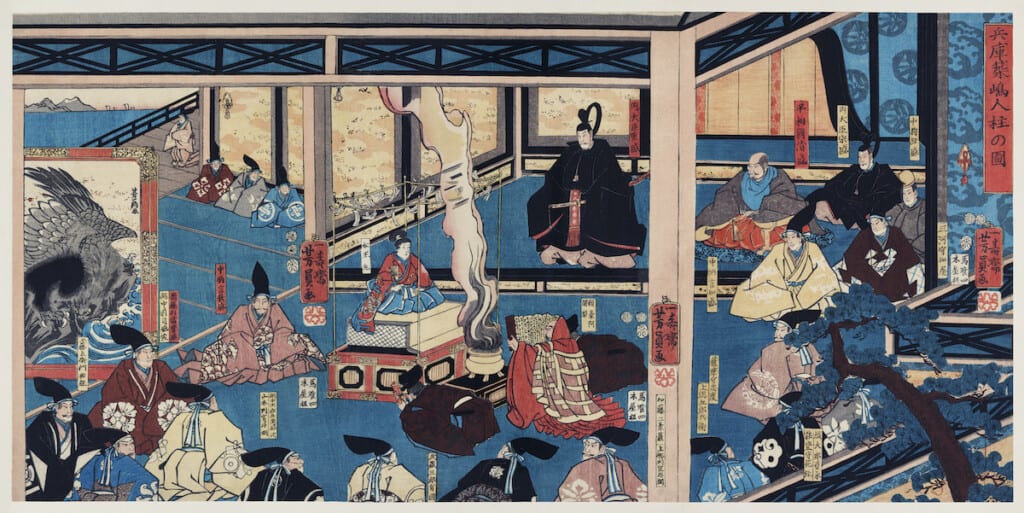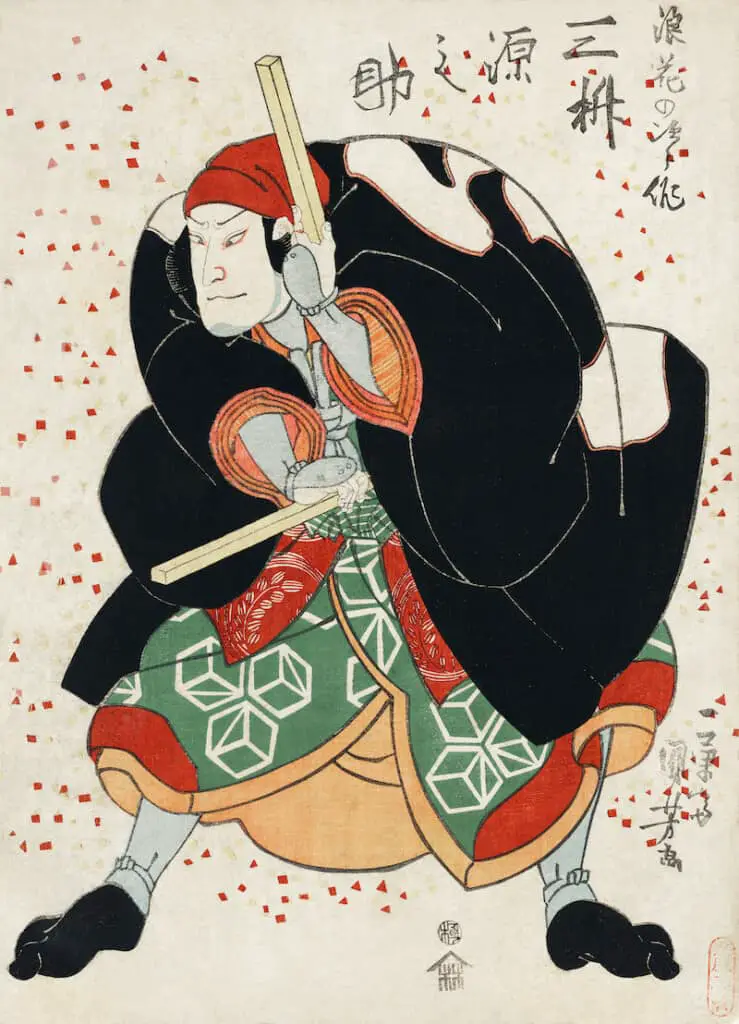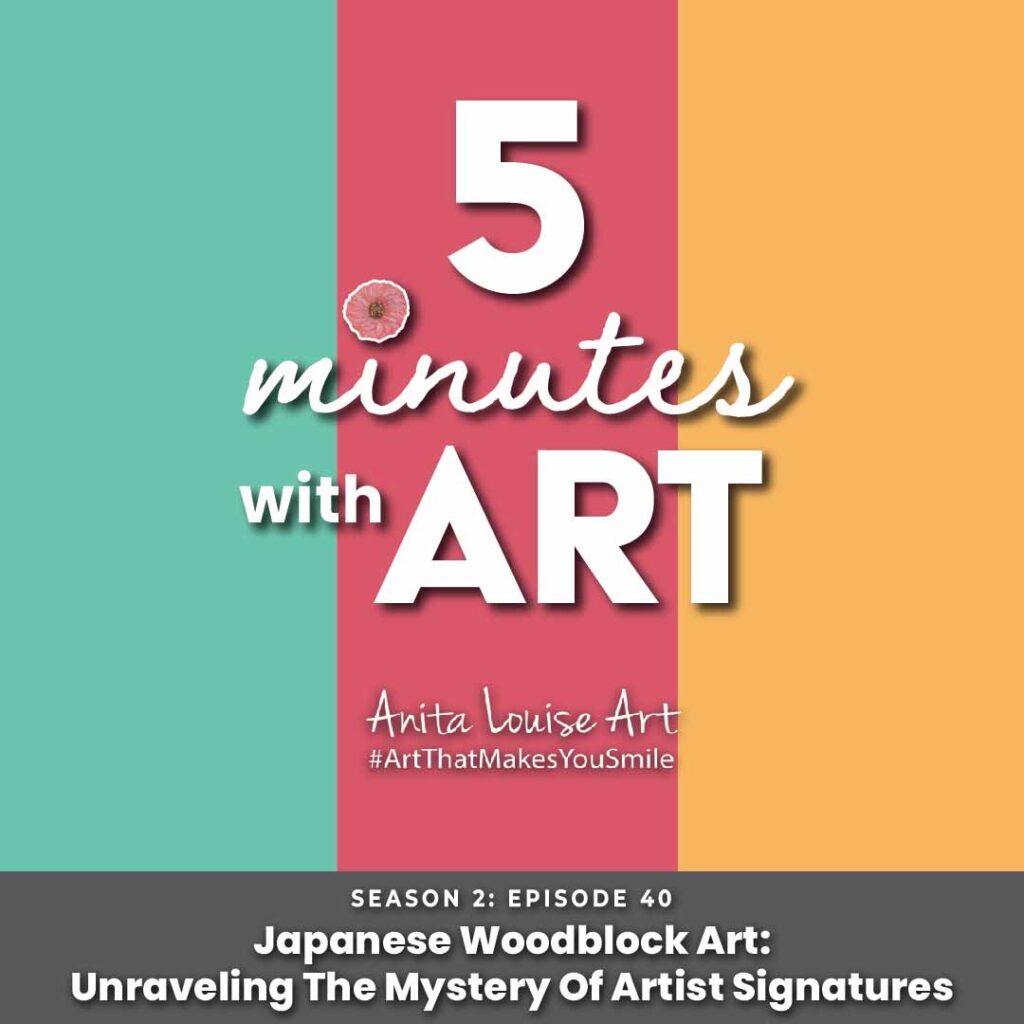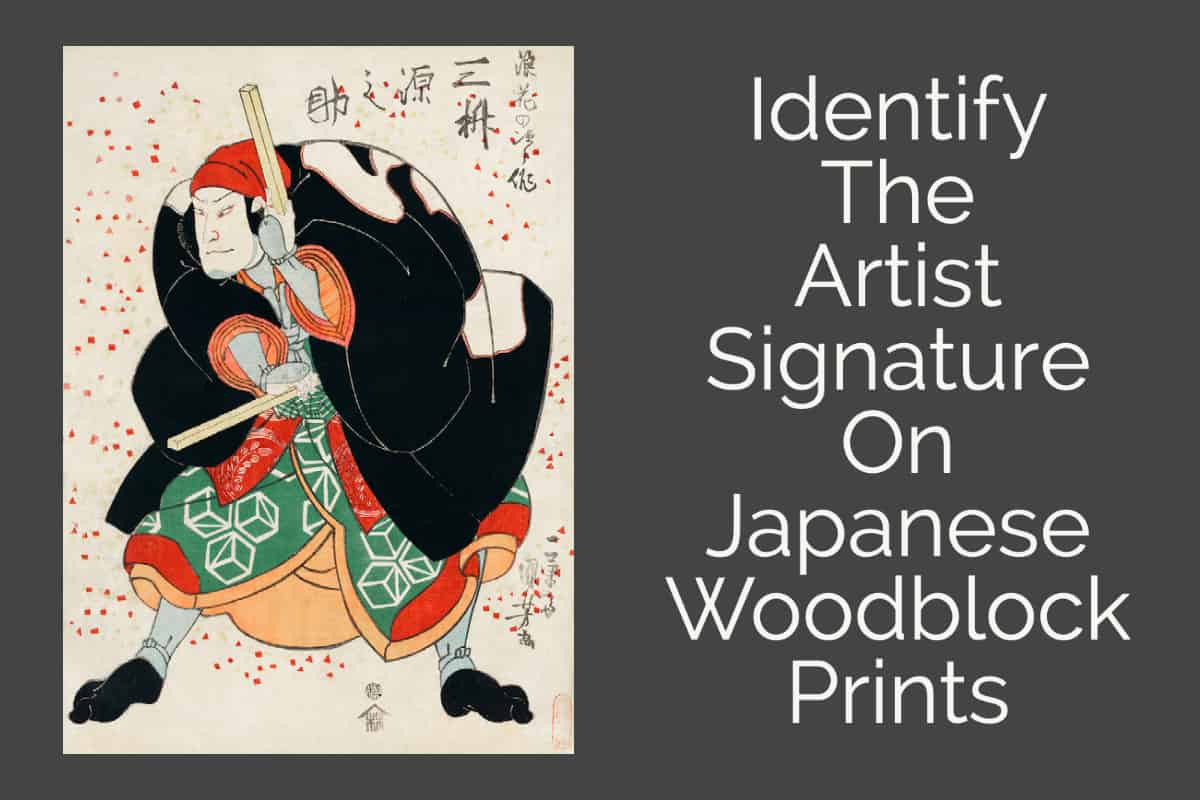In a Japanese woodblock print, it can be challenging to identify where the artist’s signature is on the print. This is because there are so many variations in where the signature can be located on a print.
The signature on a Japanese woodblock print is the Japanese characters above or near the red artistic seal or chop. Sometimes, the artist would add words behind their own name, such as “designed by.” Other times, the artist would use different chops or seals during different periods of their life. Many times, the actual artist’s signatures are complicated to read.
Table of Contents
- About The Artist’s Signature On A Japanese Woodblock Print
- The Japanese Artist Red Seal or Chop
- Different Parts of a Japanese Woodblock Print
- 10 Ways Japanese Woodblock Prints Have Influenced Art
- Frequently Asked Questions
- Related Questions
Besides the artistic signature and artist’s seal, the woodblock print may also have a title and a publisher’s seal.

About The Artist’s Signature On A Japanese Woodblock Print
Most Japanese woodblock prints will have the artist’s signature on them. The Japanese artist would sign this signature and are usually vertical characters all in a vertical row or a few rows near where the artist has placed his red artistic chop or seal.
Here are a few things to understand when you are looking at the artist’s signature of a Japanese woodblock print:
Carved Signature –
On Japanese woodblock prints, the artist usually hand-carved their signature to be used as their mark. This would then be printed with the rest of the print.
Hard to Identify –
The chisel was responsible for making the mark in the wood, and not a brush or pen signatures, so it could be very difficult to identify the actual Japanese characters used.
Used Additional Words –
Sometimes, the artist would add some words after their own name, such as “designed by.” This would make the signature appear longer than it would normally be.
Omitted Signatures –
Some artists would omit their name or signature completely from the print. This could be because the print was political or other sensitive for the time period, so they did not want to have their name or signature associated with the print.
The first thing that may surprise many people when looking at the Japanese woodblock print signatures is that they are similar to Chinese characters. In the 4th century, China had a more advanced writing system, so the Chinese writing system was introduced to Japan in the 5th and 6th centuries.
This is why on many Japanese woodblock prints, to an untrained eye or someone who doesn’t read Japanese, especially the older forms of the Japanese language, the Japanese artist characters may look very similar to Chinese. Many of them are the same, but the pronunciation would be different.

Locating The Signatures On The Japanese Woodblock Prints
The easiest way to find the signature on a Japanese woodblock print is to find the artist’s seal or chop. The signature is usually the Japanese characters above the artistic seal.
Here is some information about the artist’s signature:
Vertical Characters –
The Japanese woodblock print’s signature would be arranged vertically or from top to bottom. You would read it was going from top to bottom and from right to left.
Two to Three Characters –
The name generally consists of two Japanese characters, maybe sometimes three, and they would sometimes be followed by a suffix such as “designed by.”
Above the Artist Seal –
The artist’s signature is usually above or right next to the red artist’s seal. Looking for the red seal is another easy way to help you to identify the artist’s signature.

The Japanese Artist Red Seal or Chop
One of the easiest ways to identify the Japanese woodblock artist’s signature is to look for the artist’s chop or seal. The artist’s chop or seal is usually red in color, and the signature is usually written vertically above the chop or seal. Find the artist’s chop or seal on a woodblock print, and you can find their signature.

On the print above by Utagawa Kuniyoshi, the bottom right-hand corner shows the artist chop or seal. The artist’s signature is above the artist’s chop or seal to the slight left. Two black seals or chops between his feet are the publisher’s seals. At the very top on the right-hand side of the print is the title of the print.
In Japan and many Asian countries, having a seal, or what is known in British English as a “chop,” could be used in place or together with a signature for a legal document. This was also very true for many of the Japanese artists with their woodblock prints. They would sign the prints and then acknowledge their print by including their chop or seal.
Some people may call this seal a “stamp.” It is known as a seal or a chop in many parts of Asia. When the seal or chop is placed on something, it helps to verify whatever it is set on. This is similar to how you notarize a document; the notary would sign it and then seal it with a special kind of seal.
Some chops and seals are legally registered and could also be used as part of legal documents. For the artist to put the chop or their artistic seal on the Japanese woodblock print was really a way for them to take ownership of the print and let everyone know that they produced the print.
Each seal would be created by the artist and reflect some aspect of his life or artistic design. He could include a family crest, a studio crest, a family name, other emblems that are important to him, and even the name of a master that he admires. Sometimes, the seal or chop may be the Japanese characters of his own name. There was no set rule for what an artistic seal should or should not have on it.
About the Artist Seal Or Chops
Here are a few things about Artist seals or chops:
Red Color –
The artist’s seal is usually always red.
Secondary Artistic Mark –
The seal is considered a secondary mark for the artist.
Shape –
The most common shapes of the seal or chop are square, round, or rectangular. Some artists got creative and did other less common shapes.
Several Artist Seals –
One artist may use one seal for one piece of art and another seal. Or they might use different seals for different parts of their life. There is no rule that an artist must use the same seal or chop throughout their career.

Different Parts of a Japanese Woodblock Print
Many Japanese woodblock prints have four different components: 1) the woodblock title, 2) the artist’s signature, 3) the seal, and 4) the publisher’s mark. Not every print will have all these marks on it, so it can be confusing when looking for an artist’s signature on some of the Japanese woodblock prints. But when looking at some of the Japanese woodblock prints, it is good to know a bit about each of these sections.
Here are each of the basic sections of the Japanese woodblock prints:
Woodblock Title –
Many Japanese woodblock prints will have a title on them. This title would be about the print itself. Sometimes, this title may have a block around it to show that it is a title. This block may even be in a different color.
Artist Signature –
The artist’s signature is usually two or more Japanese characters arranged vertically and will read from top to bottom and right to left.
Artist Chop or Seal –
Most woodblock prints will have an artist chop or seal under the artist’s name, usually a red color. Looking for the red artist chop or seal is one of the easiest ways to identify the artist’s signature.
Publisher’s Mark –
Some prints will also have a publisher’s mark. This mark can be similar to the artist’s chop or seal. It is usually outlined, and the publisher’s information is inside the lines.
Some publishers would get very creative with their marks, such as having an outline of symbols such as a fish, a book, or other animals. Even if the artist has omitted his signature, the publisher may still mark the print.
Like many aspects of Asian art and, particularly, Japanese art, what may first seem very simple and basic has more detail than it first appears. This is because there is no rule as to where and how the artist signs the print.
Many artists would also use different chops or seals for other prints or periods of their lives; these differences can add to the confusion of what part of the woodblock print is the artist’s seal.
10 Ways Japanese Woodblock Prints Have Influenced Art
Japanese woodblock prints’ allure, delicate lines, vivid colors, and intricate compositions have enchanted the world for centuries. These prints, known as ‘Ukiyo-e’, meaning ‘pictures of the floating world’, made a significant impact on European art during the latter part of the 19th century, a phenomenon termed “Japonisme”.
Let’s explore ten ways in which these evocative masterpieces have shaped art and culture on a global scale:
- Introduction of Japonisme: When Japan opened its ports to international trade in the 1850s, European artists began to be exposed to Japanese woodblock prints. This initiated a craze for all things Japanese, coined as Japonisme. European artists started integrating the stylistic elements, subject matters, and compositions found in these prints into their works.
- Flat Color Areas and Bold Outlines: Unlike the shaded and modeled forms of Western art, Ukiyo-e employed flat areas of color without gradation. Artists like Vincent van Gogh and Henri Toulouse-Lautrec began using these bold, unmodulated colors and defined outlines in their paintings, moving away from the realistic renditions that were popular then.
- New Perspectives and Cropping: Woodblock prints’ unconventional perspectives and asymmetrical compositions introduced a fresh approach to framing subjects. Edgar Degas, for instance, employed these off-center, abrupt croppings in his ballet paintings, reminiscent of the prints he admired.
- Nature and Seasonality: Artists like Claude Monet were deeply influenced by how Japanese printmakers depicted the changing seasons, nature, and transient moments. Monet’s garden at Giverny, with its Japanese bridge and water lilies, is a testament to his love for Japanese aesthetics.
- Intimacy with Everyday Life: Ukiyo-e often captured intimate moments from daily life. European artists began to focus on scenes from ordinary life, shifting from grandiose historical or mythological subjects. Mary Cassatt’s tender mother-and-child compositions show this influence.
- Fashion and Textiles: The beautiful patterns, textiles, and garments in woodblock prints caught the attention of European fashion designers. Motifs and styles from these prints were incorporated into European fabrics and dress designs.
- Graphic Design and Posters: The impact of Japanese prints was significant in graphic design and poster-making. The flat color areas, bold lines, and striking compositions became integral to the Art Nouveau movement, with artists like Alphonse Mucha leading the way.
- Emphasis on Atmosphere: Instead of focusing solely on the central subject, Ukiyo-e often places equal importance on the surrounding environment, creating a harmonious atmosphere. With its atmospheric landscapes, James Whistler’s “Nocturnes” series can be linked to this influence.
- Exploration of the Ephemeral: The fleeting beauty of cherry blossoms, the transient nature of life, and the passing of seasons are central themes in Ukiyo-e. This focus on the transient and temporary deeply influenced the Impressionist movement, where capturing a momentary feeling or impression was paramount.
- A Cultural Exchange: Japanese woodblock prints initiated a broader cultural exchange beyond the visual influences. European artists developed a profound respect and admiration for Japanese craftsmanship, philosophy, and way of life, which, in turn, enriched their own practices.
Japanese woodblock prints did not merely introduce new techniques or styles; they bridged two worlds, allowing for a mutual appreciation and blending of Eastern and Western artistic traditions. The influence of these prints is a testament to art’s boundless capacity to inspire, evolve, and transcend cultural boundaries.
Listen To Our Podcast About Japanese Woodblock Art: Unraveling The Mystery Of Artist Signatures Below or By clicking here.

Anita Louise Art is dedicated to art education, great artists, and inspiring others to find and create their art. We love art that uplifts and inspires. #ArtToMakeYouSmile! #ArtToMakeYouHappy!
If you are interested in seeing any of my art, you can find out more by clicking here. If you are interested in what inspires me and my paintings, you can discover more by clicking here.
We have a free newsletter and would love you to be part of our community; you can subscribe to the newsletter by clicking here. I would be happy to talk to you if you have any questions. You can reach me, Anita, by clicking here.
Subscribe to our Anita Louise Art YouTube Channel with great videos and information by clicking here.
Join us for our podcast “5 Minutes With Art.” Spend just 5 minutes a week with us to discover and learn about great art and artists. You can find out more about our podcast by clicking here.
Frequently Asked Questions
Where can I typically find the artist’s signature on a Japanese woodblock print?
The artist’s signature is usually located above or near the red artistic seal or chop on the print.
What does the red artistic seal or chop represent on a woodblock print?
The red seal, known as a “hanko” or “chop,” is a unique mark associated with the artist, acting as a kind of personal stamp.
Do Japanese woodblock prints always feature the artist’s name in easily readable characters?
No, sometimes the artist may incorporate additional words behind their name, such as “designed by,” which can make the signature more complex.
Are there variations in the placement of the artist’s signature on woodblock prints?
Yes, there can be variations in where the signature is placed, and it may depend on the artist’s personal style or the specific print design.
Why do some Japanese woodblock prints have different chops or seals during different periods of an artist’s life?
Artists may change their seals or chops over time for various reasons, including personal evolution, shifts in style, or changes in their artistic identity.
Are there specific regions on a woodblock print where artists commonly place their signatures?
While there is no strict rule, signatures are often found in the margins, within the image itself, or along the edges of the print.
How can I differentiate between the artist’s signature and other markings on a woodblock print?
The signature is typically composed of Japanese characters and is located near the red seal. It may be helpful to consult reference materials or experts for identification.
Are there resources available to assist in deciphering complex or intricate artist signatures on woodblock prints?
Yes, there are books, online databases, and forums dedicated to Japanese woodblock prints that can provide valuable information and assistance in identifying signatures.
Do all Japanese woodblock prints have signatures?
No, not all prints are signed. Some artists chose not to sign their works, while others may have lost their signatures due to damage or wear over time.
Is it common for artists to use pseudonyms or artistic names on woodblock prints?
Yes, artists in Japan sometimes use different names or pseudonyms, known as “go” or “geimei,” for various reasons, and these alternative signatures can add another layer of complexity to identification.
Related Questions
What is The Great Wave Off Kanagawa by Japanese Artist Hokusai (1790-1849)?
The Japanese artist Hokusai produced The Great Wave Off Kanagawa woodblock print as part of his series called Thirty-six Views. The Great Wave off Kanagawa features a huge wave, a small Mount Fuji in the background, and three boats getting caught in the large wave. This print has remained so popular that it inspired music, poetry, and even a present-day emoji.
You can find out more by reading our blog post The Great Wave Off Kanagawa by Japanese Artist Hokusai (1790-1849) by clicking here.
Who Was the Chinese Painter 八大山人 Bada Shanren (1626-1705)?
Bada Shanren was born in 1626 as a Ming Dynasty Prince in Jiangxi Province, China. When the Ming Dynasty lost power, he went into hiding for over 40 years at a Buddhist Monastery. When he left the monastery, he was in his 60s and he became a professional artist. Bada Shanren made strong sounds and loud noises while he painted, so many people thought he was mad.
You can discover more by reading our blog post Who Was the Chinese Painter 八大山人 Bada Shanren (1626-1705)? by clicking here.


